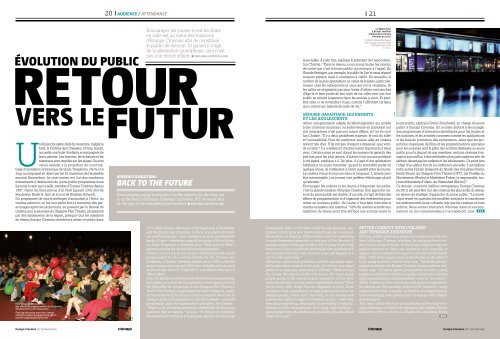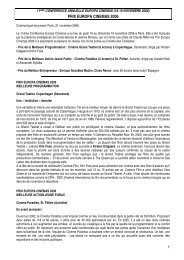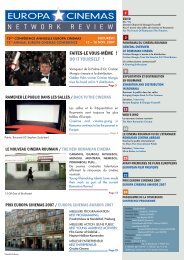Supplément du Film français - Europa Cinemas
Supplément du Film français - Europa Cinemas
Supplément du Film français - Europa Cinemas
You also want an ePaper? Increase the reach of your titles
YUMPU automatically turns print PDFs into web optimized ePapers that Google loves.
20 AUDIENCE / attendance21évolution <strong>du</strong> publicEncourager les jeunes à voir les filmsen salle est au cœur des missionsd’<strong>Europa</strong> <strong>Cinemas</strong> afin de constituerle public de demain. Et quand il s’agitde la génération smartphone, cela n’estpas une mince affaire. ■ Melanie Goodfellowretourvers lefuturUn dimanche après-midi de novembre, malgré lefroid, le Cinéma des Cinéastes, à Paris, bondé,accueille une foule d’enfants accompagnés deleurs parents. Les bonnets, les écharpes et lesmanteaux sont empilés sur les sièges. Ils sontvenus assister à la projection <strong>du</strong> court-métraged’animation britannique de Suzie Templeton, Pierre et leloup, accompagné en direct par les 30 musiciens de l’ensemblemusical Kosmofony. Le ciné-concert est l’un des nombreux Audience Evolution :événements à destination <strong>du</strong> jeune public programmé dansles mois à venir par la salle, membre d’<strong>Europa</strong> <strong>Cinemas</strong> depuisBack to the Future1997. Parmi les films prévus d’ici Noël figurent Little Bird deBoudewijn Koole et Jean de la lune de Stephan Schesch.Encouraging young audiences into the cinema for the long runDu programme de courts métrages d’animation à l’Artis, un is at the heart of <strong>Europa</strong> <strong>Cinemas</strong>’ activities. It’s no mean featcinéma estonien, où les tout-petits font la rencontre des personnagesaprès les projections, en passant par le festival dein the age of the smartphone generation. ■ Melanie Goodfellowcinéma pour la jeunesse <strong>du</strong> Glasgow <strong>Film</strong> Theatre, programmépar des adolescents de la région, presque tous les membres<strong>du</strong> réseau <strong>Europa</strong> <strong>Cinemas</strong> cherchent à attirer ce public dansLe Watershed,à Bristol, meilleurentrepreneur <strong>Europa</strong><strong>Cinemas</strong> en 2010.Bristol’s Watershed wonthe <strong>Europa</strong> <strong>Cinemas</strong> BestEntrepreneur prizein 2010.leurs salles. À juste titre, explique le président de l’association,Ian Christie : “Dans le réseau, nous avons toutes les raisonsde croire que c’est le jeune public qui manque à l’appel. EnGrande-Bretagne, par exemple, le public de l’art et essai répondtoujours présent, mais il a tendance à vieillir. En revanche, lenombre de jeunes spectateurs ne cesse de baisser, particulièrementchez les adolescents et ceux qui ont la vingtaine. Siles salles ne réagissent pas pour tenter d’attirer ces tranchesd’âge-là et faire partie de leur style de vie, elles vont voir leurpublic se ré<strong>du</strong>ire largement dans les années à venir. Et peutêtrecelui-ci ne reviendra-t-il pas, comme l’affirment certainsqui y voient une histoire de cycle de vie.”sé<strong>du</strong>ire davantage les enfantset les adolescentsAttirer une génération adepte <strong>du</strong> téléchargement qui accèdeà des contenus musicaux ou audiovisuels en pianotant surson smartphone n’est pas une mince affaire, si l’on en croitIan Christie. “Il y a deux problèmes majeurs : le coût <strong>du</strong> billetet l’accessibilité. Pour de nombreux jeunes, aller au cinémarevient très cher. S’ils ont peu d’argent à dépenser, que vontilsen faire ? Il y a tellement d’autres loisirs importants à leursyeux. Certains pays se sont donné les moyens de garantir desprix bas pour les plus jeunes, d’autres n’ont aucune politiqueà cet égard, explique-t-il. De plus, il s’agit d’une générationhabituée à un accès immédiat : quand ils entendent parler dequelque chose, ils s’attendent à l’avoir aussitôt entre les mains.Le cinéma s’inscrit toujours dans la longueur. L’attente peutêtre interminable. Les jeunes vont préférer télécharger plutôtqu’attendre.”Encourager les enfants et les jeunes à fréquenter les salles,c’est la grande mission d’<strong>Europa</strong> <strong>Cinemas</strong>. Son approche visà-vis<strong>du</strong> jeune public est double : d’un côté, il s’agit de faire desefforts de programmation et d’organiser des événements pourattirer un nouveau public. De l’autre, il faut faire connaître lecinéma européen non national. “20% <strong>du</strong> soutien accordé auxmembres <strong>du</strong> réseau peut être attribué aux actions visant le© drjeune public, explique Emilie Boucheteil, en charge <strong>du</strong> jeunepublic à <strong>Europa</strong> <strong>Cinemas</strong>. Un soutien destiné à encouragerdes programmes d’animation spécifiques pour les jeunes etles scolaires, et les activités connexes comme les publicationset les frais de promotion des événements. Alors que les projectionsclassiques de films et les programmations spécialespour les scolaires sont le pilier des activités destinées au jeunepublic pour la plupart de nos membres, certains cinémas s’essayentaujourd’hui à des méthodes plus participatives afin desé<strong>du</strong>ire davantage les enfants et les adolescents. Ce point feral’objet d’un atelier lors de la conférence annuelle. Il accueilleraentre autres Florian Deleporte <strong>du</strong> Studio des Ursulines (Paris),Emily Munro <strong>du</strong> Glasgow <strong>Film</strong> Theatre (GFT), Iris Praefke <strong>du</strong>Moviemento (Berlin) et Madeleine Probst, la responsable, toujoursdébordante d’idées, <strong>du</strong> Watershed (Bristol).”Ce dernier, couronné meilleur entrepreneur <strong>Europa</strong> <strong>Cinemas</strong>en 2010, est peut-être l’un des cinémas les plus actifs <strong>du</strong> réseauen termes de stratégie d’approche <strong>du</strong> jeune public. “Le numériqueremet en question les modèles existants et transformeles relations entre lieux culturels, tels que les cinémas et leurspublics. Nous avons conscience d’évoluer dans un environnementoù les consommateurs n’accepteront plusPour attirer le jeune public,des efforts de programmation et la créationd’événements sont nécessaires.Enticing the young ones into cinemaactivities requires programming effortsand the organization of events.© drIt’s a chilly Sunday afternoon at the beginning of Novemberand the Cinéma des Cinéastes, in Paris, is packed with childrenand their parents – hats, scarves and coats squashed intobacks of seats – attending a special screening of British directorSuzie Templeton’s animated short “Peter and the Wolf”,accompanied by the 30-piece Kosmofony ensemble.Cinema-concert is just one of many children-focused eventsprogrammed for the coming months by the Cinéma desCinéastes, a <strong>Europa</strong> <strong>Cinemas</strong> member since 1997, while thegeneral programme up until Christmas includes pictures suchas Boudewijn Koole’s “Little Bird” and Simon Schensch’s“Moon Man”.From the Estonian Artis cinema’s short animation programmefor toddlers, at which the tiny spectators meet characters fromthe films after the screenings, to the Glasgow <strong>Film</strong> Theatre’sYouth <strong>Film</strong> Festival, programmed by local teenagers, nearlyall the members of the <strong>Europa</strong> <strong>Cinemas</strong> network are active intrying to attract young audiences into their venues – and withgood reason, says the organisation’s president, Ian Christie.“There’s a lot of evidence across the network that it’s the youngaudience that is missing,” he says. “In Britain, for example,the audience for art house is holding up well, but it’s becomingincreasingly older. At the other end of the age spectrum, particularlywhere teens and twentysomethings are concerned,the audience is dipping. If the cinemas don’t do somethingto make themselves attractive to, and part of, the life-style ofyounger people in that age bracket, they’re going to see a bigre<strong>du</strong>ction in future audiences and maybe that audience willnot actually come back later, as some argue will happen as asort of a life-cycle thing.”Attracting a download generation used to accessing musicand audio-visual content at the push of a button on a smartphone is no easy feat, according to Christie.“There are twokey issues: the cost of a ticket and access. For many youngpeople, going to the cinema is quite expensive. If they havelimited funds, how are they going to spend their money? Thereare so many other things that are important to them. Somecountries have programmes to keep ticket prices lower foryounger people, others don’t. Secondly, we are dealing witha generation which is used to immediate access – when theyhear about something, they expect to get hold of it instantly.Cinema is still a slow process. It’s a long, long build-up…young people have the tendency to go looking for a downloadrather than wait.”better connect with childrenand teenager audiencesEnticing children and young people into cinemas is at the veryheart of <strong>Europa</strong> <strong>Cinemas</strong>’ activities. Its young audience fundingis two-pronged: firstly, to encourage programming andspecial activities to create new audiences and, secondly, tosupport cinema e<strong>du</strong>cation focused on non-national Europeanfilms. “20% of the support given to the theatres in the networkis for young audience-related initiatives,” Emilie Boucheteil,project coordinator for <strong>Europa</strong> <strong>Cinemas</strong>’ young audience activities,says. “It covers special programmes aimed at youngaudiences and school children as well as peripheral activitiessuch as publications and promotional costs for the events.”While traditional film screenings and special programmesfor schools are the mainstay of most of the members’ youngaudience activities, a number of theatres are experimentingwith increasingly participative ways to engage with childrenand teenagers.This topic will be the focus of a workshop at this year’s annualconference, at which the speakers will include FlorianDeleporte of Paris cinema Le Studio des Ursulines; Emily<strong>Europa</strong> <strong>Cinemas</strong> 20 e anniversaire<strong>Europa</strong> <strong>Cinemas</strong> 20 th anniversary
















